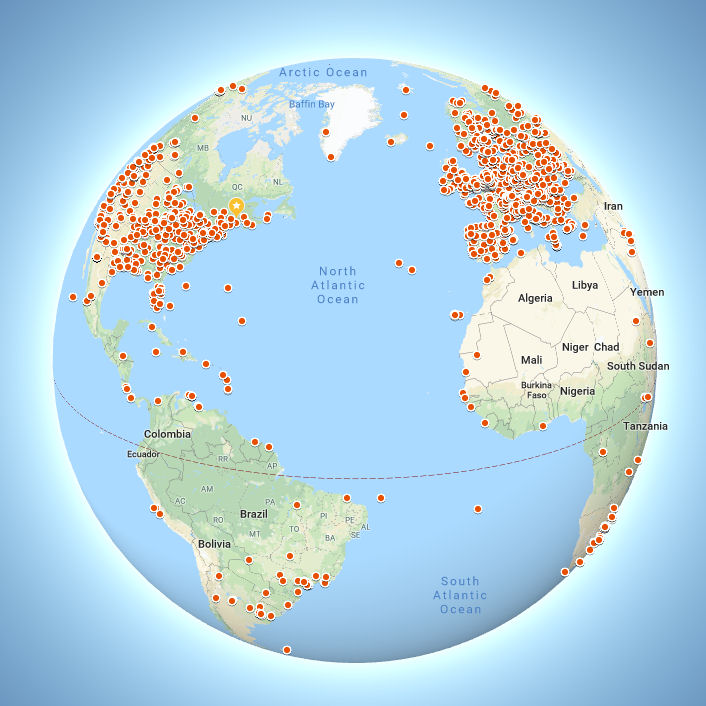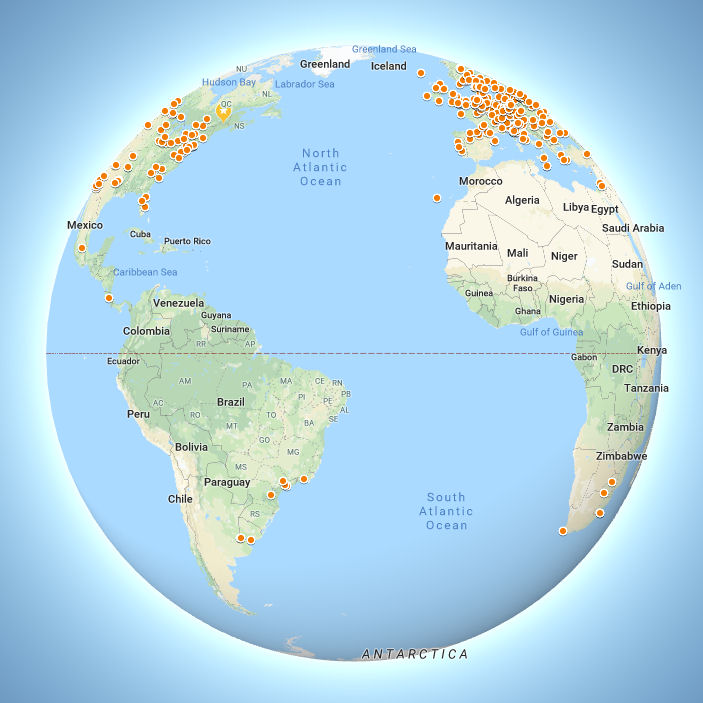Location of EME stations
UPDATE
This is a 1296 EME station map based on data from PA0PLY's EME directory and the HB9Q logger as of August 2024. Enlarge it for a better view and better control. Click on the square at upper right of map. Thanks to Jan and Dan for providing me with 1296 station data for this project.
I have not attempted to edit the databases for errors, therefore:
Note that some stations only have a 4 character Ggid location, in which case they are shown in the center of that large grid. Stations with a 6 character Grid locator are shown in the center of that smaller grid. This means that if you expand the map down to the street level, the exact position of the station will not coincide with the position on the map. For that you would need 8 character Grid locators (or better). Also, there may be errors in the database due to typo in station submissions. Stations which appear to be on no visible land presumably have an error in the grid data (or were Dxpeditions to reefs or rocks not shown on the Google Map).
Not all stations shown may be active. The problem with all directories is that while stations may enter their info when they are on the band, they do not remove it when their station is no longer active.
Not all active stations are present in this EME directories. I'm working to including data from other sources in a future update. There is no single, definitive, 1296 EME directory with no errors, all stations and only active stations. If there was, it would probably be out of date by next week anyway. I hope to include data from HB9Q in the future.
From the same data set, here is a plot of dish size vs. station number when stations are ranked by dish size. The most common dish size (median) is 3m and the average dish size (for dishes < 10m in diameter) is 3.5m. You could say that the average dish size of a station on 1296MHz EME is 3m.
The earlier page
Below is a first attempt at a map of EME stations. The basic data was extracted from the call3.txt file used with WSJT. This file contains entries for silent key, inactive stations, one time expeditions etc. so a mark on the map doesn't always indicate an active station. Only stations that are listed in the call3.txt file as EME active/capable and have a 6 character grid locator are shown.To repeat, GIGO, or in other words, "inaccurate/old data in, inaccurate/old data out". The call3.txt file contains a lot of accurate listings but not 100% of the listings are both accurate and represent an actual current EME station. If you are an active EME station and you are nor shown, all that means is that you were not listed in the version of call3.txt I used to make this map. I will be repeating the process with a more complete file when I find one. This is just a test.
If you fully zoom in on the image, the location you will see the red dot is the center of the locator grid in which the station is situated, not at the exact location of the station. Six character locator coordinates don't specify location precisely enough to identify your house!
If you are on EME and you are not listed here, you can create an entry in the mmmonvhf.de database. One you've registered and logged into the site you can create a VHF database entry at http://mmmonvhf.de/dbase.php. Any entry which lists EME, MS or WSJT as and activity is automatically added to their daily updated version of call3.txt. If you are already registered there and you're not on the map above, make sure you have EME as one of your listed activities.
Call3.txt is an non-curate file designed for use with WSJT. No-one really "maintains" it and there are many versions of it around. It's not a definitive list of all EME active stations and it's not any kind of "official" EME directory. MMMONVHF generates a copy daily from their VHF database. It contains details of stations who are, or have been, active on VHF and up bands using weak signal modes (i.e. no FM repeater operators). Weak signal modes include MS, Aurora, EME, WSJT, CW, SSB etc.
Here's an EME map based on at PA0PLY's database at www.pa0ply.nl. Not all the entries in that database have been plotted here since some lack locator information. Only 432 stations are shown at the moment.
The map can provide a quick check on database numbers. For example I don't think KG7HF is in the Atlantic ocean, 80 miles east of Portland, Maine!
Here's a first try at a 1296 EME map

Moon at +21 degrees declination (call3 stations)

Moon at -21 degrees declination (call3 stations)

Moom at zero degrees declination (1296 stations)
Useful Links:
.jpg)